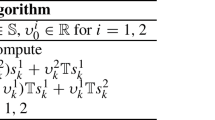Abstract
Local convergence of the Lagrange-Newton method for optimization problems with two-norm discrepancy in abstract Banach spaces is investigated. Based on stability analysis of optimization problems with two-norm discrepancy, sufficient conditions for local superlinear convergence are derived. The abstract results are applied to optimal control problems for nonlinear ordinary differential equations subject to control and state constraints.
Similar content being viewed by others
References
W. Alt, “The Lagrange-Newton method for infinite-dimensional optimization problems,” Numerical Functional Analysis and Optimization, Vol. 11, pp. 201–224, 1990.
W. Alt, “Parametric programming with applications to optimal control and sequential quadratic programming,” Bayreuther Mathematische Schriften, Vol. 35 pp. 1–37, 1991.
W. Alt, “Local convergence of the Lagrange-Newton method with applications to optimal control,” Control and Cybernetics, Vol. 23, pp. 87–106, 1994.
W. Alt and K. Malanowski “The Lagrange-Newton method for nonlinear optimal control problems,” Computational Optimization and Applications, Vol. 2, pp. 77–100, 1993.
A.L. Dontchev and W.W. Hager, “Lipschitz stability in nonlinear control and optimization,” SIAM Journal Control and Optimization, Vol. 31, pp. 569–603, 1993.
A.L. Dontchev, W.W. Hager, A.B. Poore, and B. Yang, Optimality, Stability and Convergence in Nonlinear Control, 1992 (to be published).
R. Fletcher, Practical Methods of Optimization, second edition, New York: John Wiley & Sons, 1987.
W.W. Hager, “The Ritz-Trefftz method for state and control constrained optimal control problems,” SIAM Journal Control and Optimization, Vol. 12, pp. 854–867, 1975.
W.W. Hager, “Lipschitz continuity for constrained processes,” SIAM Journal Control and Optimization, Vol. 17, pp. 321–337, 1979.
W.W. Hager, “Multiplier methods for nonlinear optimal control,” SIAM Journal Numerical Analysis, Vol. 17, pp. 1061–1080, 1990.
R.F. Hartl, S.P. Sethi, and R.G. Vickson, “A survey of the maximum principles for optimal control problems with state constraints,” SIAM Review, 1994 (to appear).
K.C.P. Machielsen, “Numerical solution of optimal control problems with state constraints by sequential quadratic programming in function space,” CWI Tract, Vol. 53, 1987.
K. Malanowski, “Second order conditions and constraint qualifications in stability and sensitivity analysis of solutions to optimization problems in Hilbert spaces,” Applied Mathematics and Optimization, Vol. 25, pp. 51–79, 1992.
K. Malanowski, “Two-norm approach in stability and sensitivity analysis of optimization and optimal control problems,” Advances in Math. Sc. and Applications, Vol. 2, pp. 397–443, 1993.
K. Malanowski, “The Lagrange-Newton method for optimal control problems subject to control-state and pure state constraints,” Preprint, 1994.
K. Malanowski, “Stability and sensitivity analysis of solutions to nonlinear optimal control problems,” Applied Mathematics and Optimization, 1994 (to be published).
K. Malanowski, “Sufficient optimality conditions in optimal control, Part 1: General results,” Technical Report WP-1-1994, Systems Research Institute, Polish Academy of Sciences, 1994.
K. Malanowski, “Sufficient optimality conditions in optimal control, Part 2: Application to stability analysis,” Technical Report WP-1-1994, Systems Research Institute, Polish Academy of Sciences, 1994.
H. Maurer, “First-and second-order sufficient optimality conditions in mathematical programming and optimal control,” Mathematical Programming Study, Vol. 14, pp. 163–177, 1981.
H. Maurer and H.J. Pesch, “Solution differentiability for nonlinear parametric control problems,” SIAM Journal Control and Optimization, 1994 (to appear).
H. Maurer and H.J. Pesch, “Solution differentiability for parametric nonlinear control problems with control-state-constraints,” Control and Cybernetics, 1994 (to appear).
S.M. Robinson, “Perturbed Kuhn-Tucker points and rates of convergence for a class of nonlinear-programming algorithms,” Mathematical Programming, Vol. 7, pp. 1–16, 1974.
S.M. Robinson, “Strongly regular generalized equations,” Mathematics of Operations Research, Vol. 5, pp. 43–62, 1980.
J. Stoer, “Principles of sequential quadratic programming methods for solving nonlinear programs,” In K. Schittkowski, (ed.), Computational Mathematical Programming, Vol. F15, pp. 165–207. Nato ASI Series, 1985.
T. Tian and J.C. Dunn, “On the gradient projection method for optimal control problems with nonnegativeL 2 inputs,” SIAM Journal Control and Optimization, Vol. 32, pp. 516–537, 1994.
Author information
Authors and Affiliations
Additional information
This research was completed while the second author was a visitor at the University of Bayreuth, Germany, supported by grant No. CIPA3510CT920789 from the Commission of the European Communities.
Rights and permissions
About this article
Cite this article
Alt, W., Malanowski, K. The Lagrange-Newton method for state constrained optimal control problems. Comput Optim Applic 4, 217–239 (1995). https://doi.org/10.1007/BF01300872
Received:
Revised:
Issue Date:
DOI: https://doi.org/10.1007/BF01300872
Keywords
- Lagrange-Newton method
- sequential quadratic programming
- two-norm discrepancy
- optimal control
- nonlinear ordinary differential equations
- state constraints




